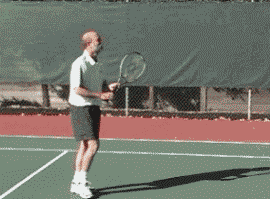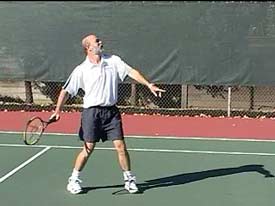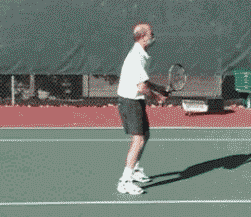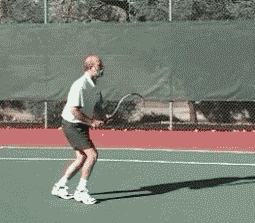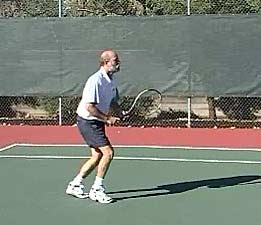|
TennisOne Lessons
|
|
|
Most students I encounter that have solid all around games usually understand the importance of variety. Yet that variety seems to be sadly lacking when the students attention is turned upward.
For this lesson, I have separated the overhead into four distinct situations: the Classic, the Scissors, the Sampras, and the Snapper. This separation process is vital to the development of on court success and most likely differentiates the greats from the rest of us. There are choices to be made and the right choice can help turn your overhead from a dreaded shot into an opportunity to close out a point - a true overhead smash!
The Classic Overhead
As the name implies this version of the overhead is the one that most players think of when they prepare to hit the shot. The "Classic" lesson that goes along with it is, "Get sideways, get your racquet up, shuffle back, left hand up, point at the ball, and make sure the ball is out front. Now reach up and hit it like you would a serve and follow through." For the most part, these are the basics for the "Classic," but let's take a closer look at the stroke.
Positioning - As soon you've recognized a lob has been sent up, move back toward the baseline along the flight path of the ball. You'll want to continue moving back until you're in position to 'swallow the falling ball' if you were to let it drop all the way.
In most cases you'll want to turn and side step or shuffle step back. Too many players face the net with their shoulders and try to run "backwards". There are at least three important reasons to move with side steps.
One, it prevents you from getting your weight too far back on your heels. This can be clumsy and I've seen players fall, and even break their wrists, by putting out their hands behind them.
Two, you can move much more quickly. Try racing with a friend (on grass, I wouldn't want you to fall on a hard court and risk injury) Make it about a 10 yard race. One of you runs backward and the other sides steps. See who wins and then switch.
Three, side stepping puts you in the optimum position to take a swing or make final adjustments steps before striking the ball.
Loading Up - Once you're in position to swallow the incoming lob, shuffle forward a bit so that the falling ball would actually land just behind you.
At this point, your weight should be mostly on your back foot. Begin to transfer your weight to the forward foot (loading it) while completing the full backswing.
Note: The front foot is pointing forward (open) making it possible for the upper body to begin the rotation process. The shot is then executed by driving up to the ball off the front foot. This makes it possible to fully extend and meet the ball in front, maximizing your weight transfer. Your hitting arm and legs should be fully extended at contact.
This can be seen if you drag the video and stop it at the moment when my right leg and right arm make a perfectly straight line.
The Swing - The swing should be much like a first serve. Use a simplified backswing getting the racquet to the up position early. From there the motion should be smooth and fluid. Make contact at full extension and slightly to the right (in line with your right shoulder). Remember, to hit a winner, you definitely won't need to reach the120 mph mark since your position on the court usually puts you much closer to your opponent than when serving.
Follow Through - The follow through is very much the same as any "classic" serve. There is no wrist snap at contact as confirmed by my colleague John Yandell in his piece Myth of the Wrist. In fact, the arm and wrist remain as one unit from contact until the follow through reaches the outer hip at which time the elbow will begin to bend facilitating a return to the ready position. The body weight will have fully transferred to the front foot placing you on balance in order to move to your "cover up" insurance position in the event the ball is returned.
|
|
The Scissor
This shot derived its name from the scissor like leg motion used while extending up to the ball. My research over the past year has confirmed what I have always expected to be the truth. The Scissors version of the overhead is in fact the dominant overhead hit at the higher levels of competition. The reason is quite obvious. Players on the tour lob well. If a tour player is hitting the Classic overhead, it's probably because the opponent threw up a poor lob.
Positioning - Like the Classic Overhead, as soon you've recognized a lob has been sent up, get yourself turned until you are parallel to the flight path of the ball. Begin the sidestep shuffle as you would for any backward movement.
Continue backward, knowing that the ball would in fact land well behind you if you don't make the effort to intercept it. As you are positioning yourself for the ball, rather than concentrating on the height of the ball just keep moving backward. Eventually the ball has to come down to a hittable level or else it will go out.
You are now going to contact the ball while you are in motion (as you are moving backward). This is a major difference between the Scissors and the Classic. With the Scissors, the load is not created from a position where you are relatively stationary.
Loading Up - Nearly everything about the loading on the Scissors is opposite of the Classic. The initial load is on the front foot but then quickly transferred to the rear foot. Now the rear leg is used to launch your body upward. The momentum from your previous steps will keep you moving backwards. Your rear leg works very much like a pole vaulter's pole, lifting your body up and backward simultaneously.
The Swing - The upper body rotation and swing are almost identical in both the Scissors and the Classic overheads, the real difference is the body angle. You'll definitely want to take a very healthy, full swing. It is the swing that helps act as a counter balance to all this backward motion. The centrifugal force you generate will keep you from falling on your head and serve to help get you moving forward, back toward the net and into position for a volley in the event your opponent is able to keep the ball in play.
The Sampras
In this day of wild looking western forehands and swinging two handed topspin volleys we often think of Pete as the epitome of the classic style. Well, Pete is in fact an innovator and should be credited with inventing this shot.
|
|
Often, when players are forced back to the baseline by a successful lob they get disheartened when they see another one being sent up.
When this happens to you, rather than getting stuck in a lobbing marathon, keep a keen eye open for a ball that is substantially shorter. As you'll see that's when the "Sampras" can make the difference (and end the point with one shot.)
Until Pete came along, the way to handle this situation was to either:
- Take the ball as a high volley, playing it safe and deep into your opponent's corner, hoping to set yourself up for the next shot.
- Let the ball bounce, then try to hit an aggressive topspin groundstroke.
Both of these options are excellent choices and should not be tossed aside, however, in each situation the opponent is given time to recover, perhaps even get in position to regain control of the point.
The advantage of the Sampras Overhead is the ball is usually put away leaving the opponent with little to do but prepare for the next point. I find the Sampras Overhead the most challenging of all the shots but definitely one of the most rewarding.
Positioning - The movement and preparation needed to execute this shot are what makes it so unique. While standing on the baseline you realize there is a short lob that's probably going to bounce near the service line. The trajectory of the ball will make it difficult to take it on the rise, and if you stay back you'll be forced to hit some type of moon ball. The solution? The Sampras overhead.
Loading Up - One unique element of this shot is that the load is simply designed to give you vertical lift, not to generate power for the shot itself. In order to obtain this, both feet are used to push up. The higher the elevation the better the angle you have to hit the ball down into the court. You'll recognize this shot because it's one that the crowds go nuts over and the one that usually bounces so high the opponent can do nothing but watch it go into the stands.
The Swing - A key to all overheads is that, once the swing has been initiated, the right shoulder always remains higher than, or at least level with the left shoulder (right-hander). Dropping the right shoulder is what brings the ball down into the net. In order to keep the shoulder from dipping Pete launches himself nearly straight upward from both feet with an open body stance. Once airborne the shot is primarily executed with an arm motion.
In the case of the Classic and Scissors overheads, the upper body is rotating at the same time as the swinging motion occurs. In the Sampras, the upper body is fully open prior to the swing.
To maximize the ability to bring the racquet and ball in a downward motion with power, the shoulder does not extend up as far as it does when executing the other shots.
Visualize you are hitting a rising balloon full of helium. Keep it from escaping by hitting it down with one hand. Hit the balloon at the highest point before it flies away. This is the arm motion for the Sampras. With the Classic and Scissor shots, energy is exerted during the upward throw, nearly the same way as quarterback would throw a long pass. With the Sampras, the energy is primarily downward.
Follow Through - In order to be effective here, you'll want to hit a flat ball. In the Sampras version, note the pronation originated from the shoulder.
|
|
The Snapper
One of the moments that can't help but put a smile on my face is when I hear someone say " I can't believe I missed that shot." (Actually they should have said "I can't believe I missed that shot again.") Sound familiar?
I hear this most about the sitting overhead - an overhead hit maybe four or five feet from the net. At the club level, this is one of the most underestimated shots simply because it requires a lot of concentration, plus a blend of elements from the other type of overheads we've examined.
Positioning - While standing somewhere near the service line your opponent sends up a pathetic excuse of a lob. The ball is probably no more than sixteen feet high and would never even make it out of the service box. Setting up for this shot is rarely a time issue. The only problem is the panic may arise from the fear of blowing such an easy shot-again! To overcome this the first step is to move, not freeze. Shuffle as close to the net as possible, while still allowing room for the ball to fall in front of you.
Loading Up - The key here is to take your time with the shot, there is no need to rush. Make sure you're on balance with your weight on the back foot of a closed stance position, very much the same as the Classic set up.
The primary load in this shot differs from the others as the emphasis on power comes from the arm and hand not the core muscle groups. The arm is up early; much like the 1/2 serve which people use when first learning to serve. The wrist is laid back which can be created by relaxing your grip to the point where there is a gap between the racquet and your palm. You should be able to feel the weight of your racquet head hanging down.
The Swing - Another element this shot shares with the Classic overhead is the transfer of weight to the front foot as you begin the full upper body rotation. It is during the arm swing that we can identify the heavy pronation and lack of shoulder extension that is shared with the Sampras.
The core of the shot, however, is the rapid snapping of the racquet head up, closing the gap in your hand. Once the gap has been filled, you'll spend most of your energy trying to slow the racquet head speed down. The racquet needs to be forced to your right before it moves in its more natural path back across your body. This will put an exclamation point on the put-away and also keep you from smashing yourself in the left shin with the racquet.
Follow Through - Here it becomes obvious why this is one of the most unique shots in the game. The follow through is as short as possible. This abbreviated motion takes a lot of strength and allows for the ball to come off the strings quickly, very much like a volley. If you fail to hold back on the follow through, continuing with a traditional follow through, the ball will stay on the strings far too long. This action will most likely pull the ball down into the net - a common error that brings us back to that "I can't believe it moment," once again.
Summary
So there you have it. There is no one overhead. There are actually four variations. Choosing the right overhead depends upon the situation, similar to the variations in the groundstrokes. You must distinguish whether you are moving forward, moving backward, or are in a stationary position, and also, where on the court you will actually make contact. Choose the right overhead and the results really will be a SMASH.
![]()
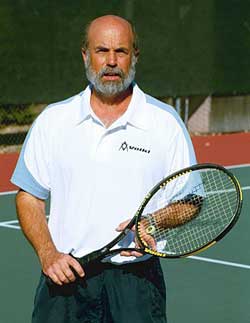 Corky Cramer, TennisONE contributing editor, is beginning a new series of articles from America's Great Teaching Pros. He is the Director of Tennis at the Montecito Heights Health and Racquet Club in Santa Rosa, California.
Corky Cramer, TennisONE contributing editor, is beginning a new series of articles from America's Great Teaching Pros. He is the Director of Tennis at the Montecito Heights Health and Racquet Club in Santa Rosa, California.
As one of the top coaches in Canadian history, he developed over 50 players who won national titles, and coached over a dozen Davis Cup and Fed Cup players. A 25 year USPTA member, Corky is also a board member for The Advanced Tennis Research Project ( www.AdvancedTennis.com ).

